Is There Something Profoundly Dysfunctional With Some
of Canada’s Anti-Poverty, Social Justice &
Children Advocacy Organizations?
© 2010 Brad Kempo B.A. LL.B.
Barrister & Solicitor
In mid-March 2010 a new initiative in reform and accountability of the country’s system of government, administration of justice and corporate Canada was launched. With five years of back-channel diplomacy having not produced the hoped for results of a voluntary change in what perpetuates and protects Chinese joint sovereignty and all that’s attendant upon it, the decision was made to generate a national awareness about this systemic corruption and criminality. It was expected that the participation rate amongst those who had a stake in changewould be high and any who chose not to would have legitimate reasons for doing so. Preliminary results indicate that a few organizations that advance the interests of children, the poor, the homeless and aboriginals are abdicating their responsibilities.
The edification campaign that commenced in August 2007 and concluded in July 2009 sought to create a collective awareness within three levels of government and the four constituents of the administration of justice (Bench, Bar, law enforcement and attorneys general) about three successive decades of unconstitutional policies and domestically and internationally illegal conduct by many of Canada’s political and corporate leaders and wealthiest families. An attribute of the dissemination initiative was creating full transparency within the growing audience of what came to be a multi-institutional abdication of professional and public interest responsibility. Where there should have been aggressive investigations by a multitude of accountability institutions followed by severe administrative discipline and criminal trials, convictions and life sentences for the most culpable and other kinds of punishment for the less complicit, there was nothing but hostility, non-cooperation, reform sabotage, stultification and whistleblower retaliation.
An evidence record was meticulously kept of all the reactions and omissions (1, 2, 3, 4), which will be presented during the national awareness campaign to prove to thirty million voters -- thirty million victims of Chinese joint sovereignty, economy monopolization and wealth embezzlement -- the Canadian state in all its manifestations must be fundamentally deconstructed and reconstituted.
Receptivity and enthusiasm was expected to be very high during the initiative launched in March 2010 to construct a coalition of organizations made up of those that have a vested interest in reform and accountability. Social justice, anti-poverty and children advocacy groups were predicted to be eager to embrace a solution that would deliver real results by doing away with a system that tossed them crumbs; by terminating that which institutionalized the inequitable distribution of wealth and opportunity and only favoured the super rich, totalitarians and triads.
Facts, figures and statistics over a thirty year period relating to the widening prosperity gap, and especially perpetual poverty, exponentially increasing homelessness and the persistence of aboriginal Third World conditions, are irrefutable proof there never has been the political will to address these problems. So why would some of the most respected groups – like ‘Campaign 2000’, ‘Canada Without Poverty’, the ‘Child Welfare League of Canada’ and ‘Canadian Association for Young Children’ – not only reject the opportunity, but do so in a way that appears to be nothing short of hostile?
The first instance of this inexplicable reaction was Laurel Rothman's, the National Coordinator for ‘Campaign 2000’. She was contacted by phone on April 9th and a ten minute introduction was made. Immediately thereafter she was sent the standard Introductory Correspondence by e-mail.
The expectation was she would be willing to join the coalition because of her organization’s positions on these critical issues:
The Liberal record on Child Poverty: 'Nobody is Perfect'
by Alan Martin
PoliticsWatch News
February 6, 2002
In 1989, 1 in 7 Canadian children lived below the poverty line. A unanimous, all party resolution, however, set out to change that. Child poverty would be eliminated by the year 2000. Twelve years on, the ratio stands at 1 in 5, or a 43 percent increase. In human terms, the difference translates into approximately 500,000 more children living in poverty.
Anti-poverty activists charge that the deterioration in conditions is a national disgrace and one of worst blights on Jean Chrétien nine-year tenure as prime minister.
[...]
"In my opinion, their record in fighting child poverty is poor, and they failed the public's expectation in this area miserably," says Liyu Guo, a spokesperson for Campaign 2000, a leading anti-poverty organization in Toronto.
[...]
"When the Chrétien government had the opportunity to spend more on social programs that would help children and families in poverty, they chose to cut taxes and reduce deficits," says Guo. "They've made commitments in word but have not fulfilled their promise in action."
"The inaction demonstrates where the focus of the government is", says Linda Lalonde, a vice-president of the National Anti-Poverty Organisation. "Clearly it is not on childcare."
"References to a "children's agenda" are sprinkled liberally through the Liberal's Red Book," says Lalonde. "That means to me that there should be identifiable projects in place." "Usually, when you say you have an agenda it means you are going to do A, B, C, D and E," she adds. "So far I've seen little or nothing advantageous being done for children in poverty."
[...]
In 1989, when Parliamentarians first voted for the initiative, it was estimated it would cost $4.6 billion to lift Canada's children out of poverty. By 1998 anti-poverty activists had placed that amount closer to $12.7 billion.
[...]
In his 1999 Budget Speech, Martin boosted about paying down almost $20 billion on the national debt over a two-year period-the fruits of the Liberals' good financial stewardship and a booming economy.
Anti poverty activists point to this as proof that the government has the resources to truly tackle child poverty.
Child poverty in Canada at same level as 1989: report
CTV.ca News Staff
October 7, 2008
Child poverty in Canada is at the same level as it was in 1989, the year Parliament pledged to eliminate the problem by 2000, says a quality-of-life report card released Tuesday.
The report, from Community Foundations of Canada (CFC), states that in 2006 there were 1.6 million children, or 23 per cent of Canadian kids, living in poverty.
"That level of child poverty has virtually not changed in about 20 years -- we just have not been able to move the needle on child poverty," CFC president Monica Patten said in a press release.
Child Poverty in Canada: Rich Nation, Poor Children
by Vipal Jain
The Toronto Star
November 20, 2009
One in nine Canadian children, more than a million, live below the poverty line according to the 2008 Report Card on Child and Family Poverty in Canada. [...] The rate of child poverty has remained at 12 per cent for two decades now, according to Statistics Canada.
It's time for Canada to develop a poverty reduction strategy
Campaign 2000
House of Commons Unanimously Resolves to End Poverty for All
As a direct result of months and years of efforts and collaboration between MPs and Campaign 2000 partners, the House of Commons Standing Committee on Human Resources, Skills and Social Development and the Status of Persons with Disabilities (HUMA) submitted a new motion, which was unanimously passed by the House on November 24th 2009; it reads:
That, with November 24th, 2009 marking the 20th anniversary of the 1989 unanimous resolution of this House to eliminate poverty among Canadian children by the year 2000, and not having achieved that goal, be it resolved that the Government of Canada, taking into consideration the Committee’s work in this regard, and respecting provincial and territorial jurisdiction, develop an immediate plan to eliminate poverty in Canada for all.
Troubling is the self-congratulatory remark “As a direct result of months and years of efforts and collaboration between MPs and Campaign 2000 partners…”. This seeks to create the perception that everything that could be done was. Yet in the final analysis all that came out of twenty years of “efforts” were these 66 words.
What is stated on the record is to be critically analyzed with these facts and statistics:
As the 11th anniversary of the House of Commons unanimous resolution "to seek to achieve the goal of eliminating poverty among Canadian children by the year 2000" approaches, the goal remains elusive. One in five children in Canada still lives in poverty - An increase of 402,000 since 1989.
Source: 2000 National Report Card on Child and Family Poverty, Campaign 2000
The report [of B.C.’s First Call], based on Statistics Canada data, shows B.C.'s child-poverty rate was 30-percent worse in 2007 than in 1989 --18.8 per cent versus 14.5 per cent.
Source: B.C.'s child poverty worst in Canada, The Province, January 12, 2010
As Laurel Rothman’s e-mail acknowledgment and follow-up communication indicate, she dismisses the offer of coalition membership within 4 minutes of receiving the e-mail. She conducted no bona fide review and analysis of the wealth of information, evidence and arguments submitted.

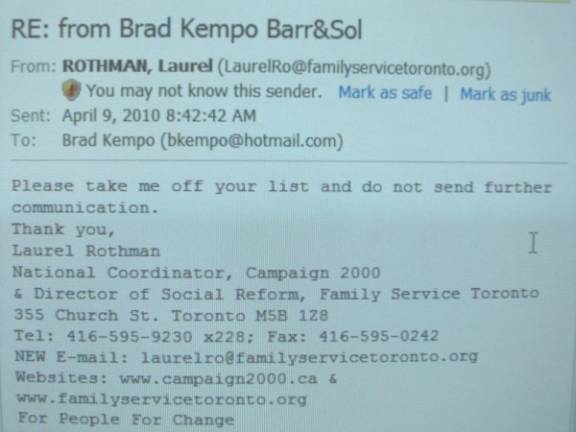
The tone of her communication is arguably hostile. It is identical to reactions by for example high-level politicians, senior lawyers and law enforcement association executives whose motivation was to protect the unconstitutional and unlawful status quo.
That sentiment was also implicit in e-mails sent in subsequent weeks by other organizations branded with the ‘unimpeachably respectable’ label. For example, ‘Canada With Poverty’ Executive Director Rob Rainer reacted thusly:
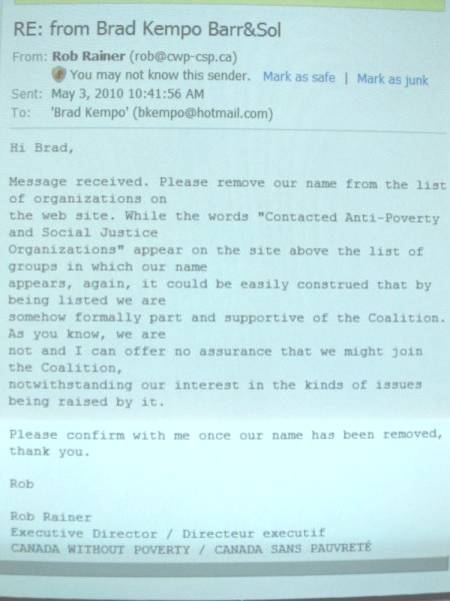
His group, previously called ‘Campaign Against Poverty’, made this public statement eight years ago:
More Canadian children living in poverty
CBC.ca
May 6, 2002
With one in five Canadian children now living below the poverty line, a child advocacy group says Ottawa must slash that number in half over the next five years.
The group called Campaign 2000 will release its report Monday, the same week the United Nations will hold its Special Session on Children.
At the 1990 UN World Summit for Children, then Prime Minister Brian Mulroney served as co-chair of the event. Prime Minister Jean Chrétien will not attend the follow up session which begins Wednesday, but will instead travel to a Canada-European Union summit in Spain.
That decision has angered child activists.
The Campaign Against Child Poverty 's June Callwood is outraged that the prime minister will not be at the conference. She says his replacement, Deputy Prime Minister John Manley, knows "diddly-squat" about children.
Callwood says she is frustrated over the government's failure to keep its 1989 promise to eliminate child poverty by the year 2000. Instead, child poverty is on the rise, claiming one in every five children from one in every seven.
Mr. Rainer was behind this reaction by Executive Peter Dudding of the ‘Child Welfare League of Canada’:

And Mr. Rainer was behind this reaction by ‘Canadian Association for Young Children’ Executive Director Deirdre Leighton:

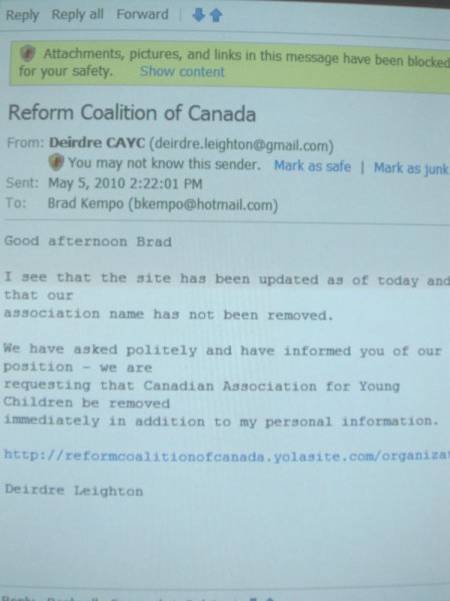
In addition, messages left repeatedly on the answering machines of other organizations like the ‘Canadian Council on Social Development’ and the ‘Centre for Social Justice’ were not returned.
The same sentiment is observed in some quarters of the aboriginal community. For example Professors Alfred and Corntassel of the University of Victoria's 'School of Indigenous Governance' were contacted and a message left for either of them to call. When neither did another attempt was made. When the omission was repeated the standard e-mail and attached introductory correspondence was delivered on April 28th. The response is identical to that of Laurel Rothman, except in one respect. While the tone was the same, the rejection was sent in three minutes, not four:
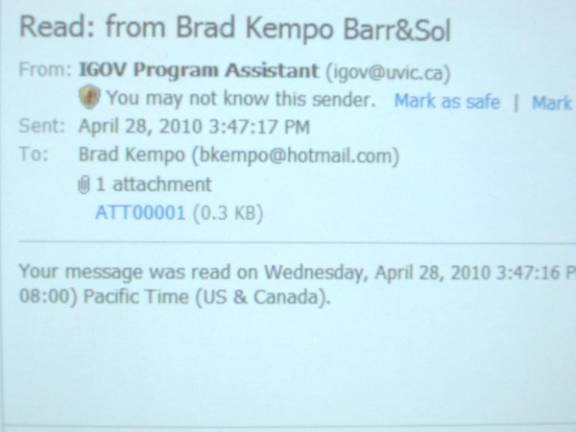
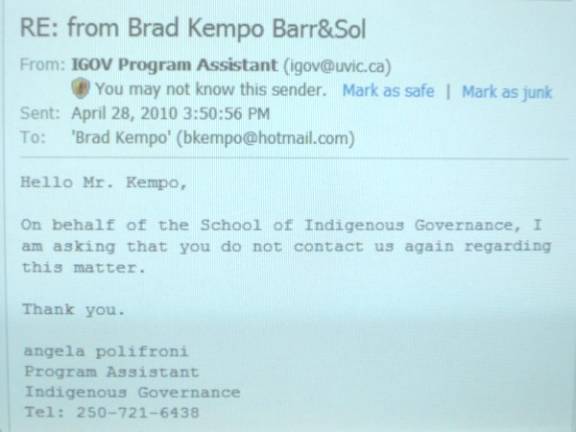
Since other countries have made enormous gains…
Parliamentary Hansard
May 4, 2004
Mr. Dick Proctor (Palliser, NDP):
How is it, after all the hand wringing, the outpouring about child poverty that has been expressed and the lip service by probably all parties in the House, that we have seen so little in the past decade and a half? How is it that countries like Sweden, Norway and Finland have found ways to reduce poverty rates well below 5%.
…it can only be concluded when all the evidence is considered that a significant amount of Canada’s wealth has for decades been surreptitiously siphoned off. What do the foregoing reactions say about agencies that represent the victims of Chinese joint sovereignty, economy monopolization and wealth embezzlement on a historic scale? There is a growingly unavoidable appearance that the kind of systemic dysfunctionality that plagues governance and the administration of justice exists in the associations that are supposed to protect society’s weakest and most vulnerable and the biggest victims of the Chinada elite. If they don't swiftly change their tone there is no room for them in the ‘new Canada’.
Research Addendum
In addition to supra and infra see Adding Another Count to the Fiefdom Indictment and Canadian Governance That Involves Institutionalized Theft and Wealth Sharing With China is Coming to an End.
2002 Oral Presentation to Federal Finance Committee
Oral Presentation to the House of Commons Standing Committee on Finance, federal pre-budget hearings
by Greg deGroot-Maggetti (2002)
Citizens for Public Justice
As Finance Minister John Manley said to you last week, we have choices to make. Will we choose to build a strong foundation for the future? Will we choose to invest in people and communities? Will we choose to take up our public responsibility to make sure that no families are faced with the terrible choice of whether to pay the rent or feed the kids?
Letter to Finance Minister John Manley regarding Child Poverty
Canadian Jewish Congress
February 3, 2003
The Honourable John Manley
Minister of Finance
L’Esplanade Laurier
140 O’Connor Street
Ottawa, Ontario K1A OG5
Dear Mr. Manley,
I am writing to you on behalf of the Canadian Jewish Congress (CJC), a national partner in Campaign 2000. We are pleased to participate in the efforts of the Campaign to address the critical issues related to child and family poverty in Canada and respectfully urge you to assign them a high priority.
Assuring the health and well-being of all people has always been a core value in Jewish tradition - which has always held a deep respect for life and healthy living. Providing for the basic needs of all its citizens, including the alleviation of poverty, is also viewed as a moral obligation for society. Jewish law and ethics prescribe that the community has a fundamental obligation to save lives whenever possible. Thus, the values that aim to abolish poverty are at once quintessentially Canadian and intrinsically Jewish.
The CJC believes that strategies and resources are needed to improve the diminished life chances for low-income children and families to lead Canadians toward a society of social inclusion. We recognize that child and family poverty is also an economic issue requiring strategies that enable healthy, well stimulated and nurtured children to grow and blossom into the human capital that Canada needs to prosper. Child and family poverty is also about making the diversity of Canada work effectively to ensure the full integration of newcomers to Canada.
The CJC is encouraged by the commitments in the Speech from the Throne and looks forward to the federal government’s leadership, alongside the provinces and territories, in securing a multi-year plan which would include a mix of income measures and community services. We are hopeful the governments will establish a framework for a universally accessible system of Early Childhood Education and Care (ECEC) which would include financial resources for year-by-year expansion, and a similar level of commitment for the National Child Benefit as debt reduction has enjoyed. We also encourage the federal government to ensure that sufficient affordable housing is available to those in need. In order to ensure accountability of public funds, the federal government could seriously consider re-instituting conditionality in the transfer of public funds for social programs including income security, ECEC, and affordable housing.
The CJC supports the recommendations put forward by Campaign 2000. We respectfully urge you to fully implement this social investment program.
Yours sincerely,
Keith Landy, President, Canadian Jewish Congress
Zena Simces, Chair, Social Action Committee, Canadian Jewish Congress
Rethinking Canadian economic and social policy
by Greg deGroot-Maggetti
Citizens for Public Justice (2003)
[There are] stubbornly high rates of child poverty in Canada...
The National Child Benefit program was created in 1998.
[...]
The NCB has had mixed results in reducing child poverty. It has provided more income for low- income families with paid work. But in provinces that have "clawed back" the NCB supplement from social assistance, those families have experienced stagnation or decline in their incomes, since social assistance rates have generally not been adjusted for inflation.
Speech by the Honourable John Manley
Deputy Prime Minister and Minister of Finance
Canadian Club and Empire Club
February 20, 2003
[...]
[A]nswering the needs of our cities is not just about investments in bricks and mortar. It is also about investments in the lives of people and especially the people who find themselves at the margins of our communities. It is about our investment in health care. It is about our action on child poverty.
Poverty in Canada: The New Reality Facing Canadians
by Scott Fogden
mapleleafweb.com
February 20, 2003
It usually takes grim statistics to get poverty into the headlines. This winter, a number of different organizations produced reports that detail Canadian poverty levels. In November, the Canadian Council on Social Development released its figures for child poverty, followed closely by Statistics Canada’s first ever tally of the number of Canadians living in shelters.
The reports highlight the enduring nature of poverty, even in modern, developed societies like Canada’s. x But they also documented some unsettling increases for a number of key poverty indicators. For example, the number of people relying on food banks has escalated, as well as the numbers of Canadians living below the accepted low-income cut-off point.
The Budget Speech 2003
The Honourable John Manley, P.C., M.P.
Deputy Prime Minister and Minister of Finance
February 18, 2003
In the last half of the 20th century we committed, as a national project, to confront poverty among the elderly. The challenge of this generation is to provide the same attention and the same focus to dealing with child poverty, and to ensure that all Canadian children have a good start in life. […] Since [the] introduction [of the National Child Benefit…] we have seen a real reduction in child poverty. We must, however, do more—much more.
Finance minister plays budget booster: Manley faces tough questions at U of M stop
by Joel Trenaman
The Manitoban
March 19, 2003
Manley’s speech and the resulting questions were not limited to matters of post-secondary education. He spoke of the need to balance the interests of Canadians by increasing funding to areas like the reduction of child poverty...
2000 National Report Card on Child and Family Poverty
Campaign 2000
As the 11th anniversary of the House of Commons unanimous resolution "to seek to achieve the goal of eliminating poverty among Canadian children by the year 2000" approaches, the goal remains elusive.
One in five children in Canada still lives in poverty - An increase of 402,000 since 1989.
"We are a nation of unmatched diversity and tolerance, ... A nation unshakably committed to ensuring that none of our people is left behind as we move ahead ... This means ensuring that all Canadian children have the best possible start in life."
Prime Minister Jean Chrétien, Summer 2000
2002 National Report Card on Child and Family Poverty
Campaign 2000
"Mr. Speaker, we must put Canada's families and children first...we will begin immediate consultations with our partners so as to be ready in the next budget to put in place a long term investment plan. To enable Canada to turn the corner on child poverty and break the cycle of poverty and dependency for Canadian families."
Prime Minister Jean Chrétien in Reply to the
Speech from the Throne, October 2002
Despite consecutive years of economic growth, poverty retains its stubborn hold on more than 1.1 million children in Canada. Robust growth and social investments in income support policies are finally contributing to an expected decline in the rate of child poverty - the number of poor kids has dropped from one in five, to one in six for the first time since 1989. Yet, the one child in six children who remain in low income families have not experienced much of an improvement in their living standards. In the midst of growing prosperity, low income families still struggle far below the poverty line. In 2000, two parent families continued to fall deeper into poverty and would need, on average, $10,032 just to reach the poverty line. Despite some improvement, female-led lone parent families would still require an additional $8,510 to reach the poverty line.
2006 National Report Card on Child and Family Poverty
Campaign 2000
Oh Canada! Too Many Children in Poverty for Too Long
In 1989, the House of Commons unanimously resolved to "seek to achieve the goal of eliminating poverty among Canadian children by the year 2000." Yet, close to 1.2 million children - almost one child out of every six in Canada - still live in poverty.
How Poor is the Average Low Income Family?
The average low income family is living in deep poverty. The average two parent low income family would need an additional $10,400/year to bring them up to the poverty line. The average female lone parent family is living 9,400 below the poverty line. In spite of a strong economy the average low income two parent family is still living as far below the poverty line as they were 11 years ago.
Ontario Hansard
October 2005
Hon. Joseph Cordiano (Minister of Economic Development and Trade):
I would point to Roger Martin's studies on productivity rates. When he looked at the prosperity gap between Ontario and 16 jurisdictions in North America, we were 13th out of 16.
British Columbia Hansard
February 20, 2007
Jagrup Brar (NDP):
We are a rich province, but one where the most vulnerable people — 24 percent of our kids — have been left out. The gap between rich and poor is growing every day since this government took over in 2001. That gap is now the widest in Canada.
Denise Savoie (NDP):
A report came out just in the new year and showed that since 1999 the richest 20% have received over 70% of the wealth growth in Canada. In 2005 the minimum wage increased by 4.2%, while the average CEO's salary increased by 39%.
It is not just about CEOs. The income gap between rich and poor is widening in Canada. Since the mid-1990s, and let us call them the Liberal years, Statistics Canada's most recent “Income in Canada” report shows that between 1995 to 2004 the average after-tax income of the poorest one-fifth of Canadians increased by $400. That is not great for a whole decade when we consider inflation and cost of living. But the average after-tax income of the wealthiest one-fifth of Canadians increased not by $400 but by $20,000, 50 times the amount of the poorest fifth.
In my own city of Victoria, the average income was approximately $55,000 and 60% of the households made less than the average income. One-fourth are living below the poverty cutoff and 12% of households made over $100,000. How can these extraordinarily unjust inequalities exist in a market that supposedly works?
As a social democrat, I believe that the economy ultimately must be judged by how well it serves the needs of all the people. Instead, glowing reports of the economy's performance and massive federal surpluses were funnelled to corporate tax cuts over the years, not personal tax cuts but corporate tax cuts, and those are still going down.
Girl Homelessness in Canada
Prepared for Parity Magazine Australia
February 2007
Justice for Girls is a Canadian non-profit organization that promotes equality, justice and support for teenage girls living in poverty. Our understanding and approach to girls’ conflict with the law begins with the premise that inequality and violence are pervasive and severe in the lives of young women who live in poverty.
Homelessness has been identified as a significant problem in Canada. Teenage girls makeup between 6 and 12 percent of all homeless people in the country.
Homeless girls endure frequent and severe male sexual and physical violence, grossly inadequate and dangerous housing conditions, criminalization, serious and sometimes fatal health disorders, and many other devastating consequences.
Teenage girls are one of the most vulnerable groups in society. Marginalised within the category of children as females, and within the category of women as minors, young women, and the issues that affect them, are often eclipsed by larger concerns general to youth or women. Additionally, the intersections of discrimination that girls experience -such as homophobia, racism, colonization and poverty – exacerbate the disparities already experienced by girls as a result of their age and gender.
Aboriginal girls in Canada are disproportionately represented amongst homeless girls. Young Aboriginal women face multiple and extreme oppression through colonization, male violence, racism, poverty and institutionalization. These compounding oppressions make Aboriginal girls especially vulnerable to becoming homeless. The rate of physical and sexual abuse of young Aboriginal women is extremely high. In a recent Vancouver study, 42 percent of homeless girls were found to be of Aboriginal descent.
[…]
The failure of the State to adequately house and support teenage girls who are on their own often forces girls to live with men who are violent and exploitative.
Child poverty – this is not as good as it gets
by Plaurel Rothman & Armine Yalnizyan
Globe & Mail
May 9, 2007
Canada’s child and family poverty rate is down to 11.7 per cent in the latest Statistics Canada report, released last week. So why aren’t anti-poverty activists breaking out the bubbly?
Because that rate is exactly what it was in 1989, when parliamentarians unanimously declared it unacceptable, vowing to eliminate child poverty by the year 2000.
It is always welcome news when the child poverty rate turns downward, but it’s not time to celebrate something that was unacceptable a few years ago. In 1989, the Canadian economy had just begun to climb out of its deepest recession since the 1930s. Today, the economy is firing on all cylinders in most parts of the country, and it’s been that way for years. Why such willingness to write off the fortunes of almost 12 per cent of this generation of children in a country that’s enjoying such economic fortune? We don’t believe this as good as it gets.
The sobering reality is that in Canada more than three-quarters of a million children live in poverty. That’s about one in eight children. Some people call that a victory. We beg to differ.
Canada has a $1.3-trillion economy. It has doubled, in real terms, over the past 25 years, making it the ninth-largest in the world.
Unemployment is at a 30-year low. That means Canadians are working. In fact, they are working harder than ever. We are all contributing to Canada’s growing economy. Even the poorest among us are working more. Yet, one in every three low-income children has a parent working full-time all year, and it’s still not enough to pull them out of poverty. A sizzling economy and plentiful jobs aren’t enough to pull poverty rates down to those enjoyed in many countries with less robust economies.
In its latest report on income distribution, the Canadian Centre for Policy Alternatives found that, although the economic pie is bigger and there is indisputably more affluence in the land, Canada’s poorest families are earning less than they did a generation ago.
In stark contrast, the richest 10 per cent of Canadian families are enjoying a cool (inflation-adjusted) 30-per-cent increase in their income compared to a generation ago.
The average earnings of the richest 10 per cent of families are now 82 times those of the poorest 10 per cent. A generation ago, they made 31 times more than the poorest.
The result is that Canada’s after-tax income gap between the richest and poorest 10 per cent of families raising children is at its highest level in 30 years. The gap is growing and we are leaving our poorest behind.
And those who are poor are experiencing a deeper level of poverty today than before. A typically “poor” two-parent family needs an additional $9,100 just to reach the poverty line.
Government support makes a difference. Programs such as unemployment insurance and social assistance, which have seen deep cuts, still prevent the freefall of many of our poorest families. The National Child Benefit makes a bigger difference to poor families than a decade ago.
Yet, simply stated, our governments are not doing enough.
If we, as a nation, refuse to tackle poverty during one of the most economically flush eras of the past century, when are we likely to take the challenge? During the next recession? There is a huge cohort of Canadians poised to retire in the coming decade. Are we really ready to write off every eighth child, permit them to develop into adulthood without adequate investments in their health, welfare and development? We will need every single one of these children to help support us in 15 to 20 years.
These children represent our future, the best of this country’s expectations for progress. There is no time to waste. It’s time for a cross-Canada comprehensive, long-term poverty reduction strategy.
Newfoundland and Quebec are showing it can be done provincially. These provinces are investing in family income support programs, training and education, child care, and affordable housing — the type of investments that other countries have found successful in reducing poverty rates. Canadians have told pollsters that these are precisely the measures they want governments to take to reduce poverty and growing income inequality.
Can we afford it? Yes. But we need political leadership to make it happen. Canada’s economy is chugging away, continuing to surpass expectations quarter after quarter. The federal government has committed to spend $35-billion in surplus funds over the next three years for other things, but not a dime is going to reduce poverty.
We didn’t accept child poverty as a sustainable option in 1989. We shouldn’t accept it now.
Homelessness 'chronic' in Canada: study
CBC News
June 26, 2007
Canada's homeless population is somewhere between 200,000 and 300,000 people, while another 1.7 million residents struggle with "housing affordability issues," says an analysis of the latest research on shelter.
In a report released Tuesday from the Calgary-based Sheldon Chumir Foundation for Ethics in Leadership, journalist and author Gordon Laird argues homelessness is now chronic and is quickly becoming one of the country's defining social issues. He makes a case for a national housing strategy and a more robust income security program.
Citing statistics from a wide range of organizations, Laird says poverty is the leading cause of homelessness in Canada, not substance abuse or mental illness. "Roughly half of all Canadians live in fear of poverty, and 49 per cent polled believe they might be poverty stricken if they missed one or two paycheques," he writes.
Laird is a media fellow with the foundation, which works to influence ethical actions in politics, business, government and the community.
In his report, Laird writes that street counts of homeless people have increased dramatically — "Calgary's homeless population grew 740 per cent between 1994 and 2006."
He cites government numbers showing a cost of up to $6 billion a year to service a "core" homeless population of 150,000. That cost includes health care, criminal justice, social services and emergency shelter costs.
"The high cost of homelessness in Canada results from the role of homelessness as a proven multiplier of societal ills: malnutrition, unemployment, addiction, mental illness, family strife and lack of income security are all intensified when an individual or household becomes homeless," he writes.
The report criticizes Canada for trying to contain the growth of homelessness with temporary measures such as shelters and other crisis-based services. It cites studies that show the cost of emergency shelters is much greater than the cost of creating affordable housing and implementing rent supplements.
Laird says the former national affordable housing strategy, discontinued in 1993, created 650,000 units providing housing for more than two million Canadians. While new investments in affordable housing were made in 2005, there is no national strategy and so no guarantee the money will be well-spent, he says."And without a national strategy on housing and homelessness, there is much risk for repeating past mistakes and spending blindly on short-term fixes and emergency responses," writes Laird.
10,000 Homeless in BC
Homelessness is booming in B.C.'s suburbs
by Monte Paulsen
TheTyee.ca
November 30, 2007
More than 10,580 British Columbians are homeless this winter, according to a survey of estimates compiled by the New Democratic Party. And the ranks of the unsheltered are growing fastest not in the province's largest cities, but in B.C.'s booming exurbs such as Abbotsford and Whistler.
"We are sometimes fooled into thinking homelessness is a Vancouver issue," said MLA David Chudnovsky, the opposition critic who conducted the study. "But these numbers show that homelessness is a province-wide crisis."
"nterviews with social workers and homeless individuals in the Fraser Valley confirm the NDP's findings.
B.C. the worst in Canada for child poverty
CBC News
November 21, 2008
British Columbia has the highest rate of child poverty in the country, a dubious distinction the province has won for five straight years.
According to the advocacy group First Call, which issued its annual Child Poverty Report Card on Friday morning, B.C.'s child poverty rate is 22 per cent, six per cent higher than the national average.
Based on 2006 statistics, the Vancouver-based organization said 181,000 children in B.C. are living below the poverty line.
Those numbers can cause disastrous results for the province's affected children, First Call's Adrienne Montani said, including "school failure, doing poorly in school or dropping out early, poor health, life-long consequences for their health. It means they may become vulnerable to justice system involvement, especially as they hit their teens."
[...]
NDP health critic Adrian Dix blamed the government of Premier Gordon Campbell. "You'll remember the largest cut in the first round of Campbell cuts was the Ministry of Children and Family Development. They got rid of the children's commission, the child advocate."
B.C.'s child poverty rate still Canada's highest
The Canadian Press
November 24, 2009
British Columbia's child poverty rate has remained the highest in Canada for six years in a row and it's time the provincial government took action, according to a child and youth advocacy group.
In its annual Child Poverty Report Card released Tuesday, the advocacy group First Call said B.C. had 156,000 poor children in 2007 — even though that was a good year for the provincial economy.
"When will the provincial government take action?" asked First Call chairwoman Julie Norton, who released the report on the 20th anniversary of an unanimous House of Commons vote to end child poverty in Canada by 2000.
The proportion of children living in poverty in B.C. was 18.8 per cent, while the national child poverty rate was 15 per cent, according to Statistics Canada data cited in the report.
"We've been at the bottom year after year after year, and our elected officials still don't take seriously the pain and suffering that poverty causes children and their families," said Norton.
B.C.'s child poverty worst in Canada
Kids more likely not to eat well, to do poorly in school, drop out early
by Kent Spencer
The Province
January 12, 2010
B.C. children are more likely to load up on cheap, unhealthy food and go without warm winter clothes than children in any other province, says a child advocacy group.
The First Call child coalition released a report Monday that shows B.C.'s record for child poverty was the worst in the country during the years 1989 to 2007.
Adrienne Montani of First Call said that means youth up to age 18 are more likely to suffer deprivations here than any place in Canada.
"It means loading up on cheap calories, not fruits or vegetables," Montani said. "With poor nutrition, they may not be ready to learn in the classroom.
"There are high dropout rates and pressure to go to work as teenagers."
The report, based on Statistics Canada data, shows B.C.'s child-poverty rate was 30-percent worse in 2007 than in 1989 --18.8 per cent versus 14.5 per cent.
[...]
Mary Ellen Turpel-Lafond, an independent legislative officer charged with child welfare, called the problem "significant."
"I'm very concerned about very low social-assistance rates, that children aren't able to eat healthy food," Turpel-Lafond said.
"The gap in B.C. has grown between the haves and the have-nots."
"I've seen tragic cases of family breakdowns and harm to children."